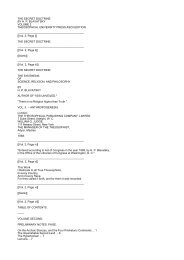You also want an ePaper? Increase the reach of your titles
YUMPU automatically turns print PDFs into web optimized ePapers that Google loves.
The Gods Of The <strong>Book</strong> Of The <strong>Dead</strong>.<br />
depicted in human form, sometimes with a crown upon his head and sceptre I in his right hand; and<br />
sometimes he has upon his head a goose,[4] which bird was sacred to him. In many places he is called<br />
<strong>the</strong> "great cackler" and he was supposed to have laid <strong>the</strong> egg from which <strong>the</strong> world sprang. Already in <strong>the</strong><br />
pyramid texts he has become a god <strong>of</strong> <strong>the</strong> dead by virtue <strong>of</strong> representing <strong>the</strong> earth wherein <strong>the</strong> deceased<br />
was laid.<br />
[1. See Lanzone, op. cit., tav. 385.<br />
2. See Lanzone, op. cit., tav. 395.<br />
3. Recueil de Travaux, t. v., p. 10 (l. 61).<br />
4 See Lanzone op. cit. tav 346.]<br />
{p. cxiii}<br />
Ausar or Osiris, <strong>the</strong> sixth member <strong>of</strong> <strong>the</strong> company <strong>of</strong> <strong>the</strong> gods <strong>of</strong> Annu, was <strong>the</strong> son <strong>of</strong> Seb and Nut, and<br />
<strong>the</strong> husband <strong>of</strong> his sister Isis, <strong>the</strong> fa<strong>the</strong>r <strong>of</strong> "Horus, <strong>the</strong> son <strong>of</strong> Isis," and <strong>the</strong> bro<strong>the</strong>r <strong>of</strong> Set and Nephthys.<br />
The version <strong>of</strong> his sufferings and death by Plutarch has been already described (see p. xlviii.). Whatever<br />
may have been <strong>the</strong> foundation <strong>of</strong> <strong>the</strong> legend, it is pretty certain that his character as a god <strong>of</strong> <strong>the</strong> dead was<br />
well defined long before <strong>the</strong> versions <strong>of</strong> <strong>the</strong> pyramid texts known to us were written, and <strong>the</strong> only<br />
important change which took place in <strong>the</strong> views <strong>of</strong> <strong>the</strong> Egyptians concerning him in later days was <strong>the</strong><br />
ascription to him <strong>of</strong> <strong>the</strong> attributes which in <strong>the</strong> early dynasties were regarded as belonging only to Ra or<br />
to Ra-Tmu. Originally Osiris was a form <strong>of</strong> <strong>the</strong> sun-god, and, speaking generally, he may be said to have<br />
represented <strong>the</strong> sun after he had set, and as such was <strong>the</strong> emblem <strong>of</strong> <strong>the</strong> motionless dead; later texts<br />
identify him with <strong>the</strong> moon. The Egyptians asserted that he was <strong>the</strong> fa<strong>the</strong>r <strong>of</strong> <strong>the</strong> gods who had given him<br />
birth, and, as he was <strong>the</strong> god both <strong>of</strong> yesterday and <strong>of</strong> to-day, he became <strong>the</strong> type <strong>of</strong> eternal existence and<br />
<strong>the</strong> symbol <strong>of</strong> immortality; as such he usurped not only <strong>the</strong> attributes <strong>of</strong> Ra, but those <strong>of</strong> every o<strong>the</strong>r god,<br />
and at length he was both <strong>the</strong> god <strong>of</strong> <strong>the</strong> dead and <strong>the</strong> god <strong>of</strong> <strong>the</strong> living. As judge <strong>of</strong> <strong>the</strong> dead he was<br />
believed to exercise functions similar to those attributed to God. Alone among all <strong>the</strong> many gods <strong>of</strong><br />
Egypt, Osiris was chosen as <strong>the</strong> type <strong>of</strong> what <strong>the</strong> deceased hoped to become when, his body having been<br />
mummified in <strong>the</strong> prescribed way, and ceremonies proper to <strong>the</strong> occasion having been performed and <strong>the</strong><br />
prayers said, his glorified body should enter into his presence in heaven; to him as "lord <strong>of</strong> eternity," by<br />
which title as judge <strong>of</strong> <strong>the</strong> dead he was commonly addressed, <strong>the</strong> deceased appealed to make his flesh to<br />
germinate and to save his body from decay.[1] The various forms in which Osiris is depicted are too<br />
numerous to be described here, but generally speaking he is represented in <strong>the</strong> form <strong>of</strong> a mummy wearing<br />
a crown and holding in his hands <strong>the</strong> emblems <strong>of</strong> sovereignty and power. A very complete series <strong>of</strong><br />
illustrations <strong>of</strong> <strong>the</strong> forms <strong>of</strong> Osiris is given by Lanzone in his Dizionario, tavv. 258-299. The ceremonies<br />
connected with <strong>the</strong> celebration <strong>of</strong> <strong>the</strong> events <strong>of</strong> <strong>the</strong> sufferings, <strong>the</strong> death and <strong>the</strong> resurrection <strong>of</strong> Osiris<br />
occupied a very prominent part in <strong>the</strong> religious observances <strong>of</strong> <strong>the</strong> Egyptians, and it seems as if in <strong>the</strong><br />
month <strong>of</strong> Choiak a representation <strong>of</strong><br />
[1. Compare ###. Naville, Todtenbuch, Bd. I., Bl. 179.]<br />
{p. cxiv}<br />
<strong>the</strong>m took place in various temples in Egypt; <strong>the</strong> text <strong>of</strong> a minute description <strong>of</strong> <strong>the</strong>m has been published<br />
by M. Loret in Recueil de Travaux, tom. iii., p. 43 ff, and succeeding volumes. A perusal <strong>of</strong> this work<br />
explains <strong>the</strong> signification <strong>of</strong> many <strong>of</strong> <strong>the</strong> ceremonies connected with <strong>the</strong> burial <strong>of</strong> <strong>the</strong> dead, <strong>the</strong> use <strong>of</strong><br />
amulets, and certain parts <strong>of</strong> <strong>the</strong> funeral ritual; and <strong>the</strong> work in this form being <strong>of</strong> a late date proves that<br />
http://www.sacred-texts.com/egy/ebod/ebod09.htm (5 <strong>of</strong> 19) [8/10/2001 11:23:58 AM]

















